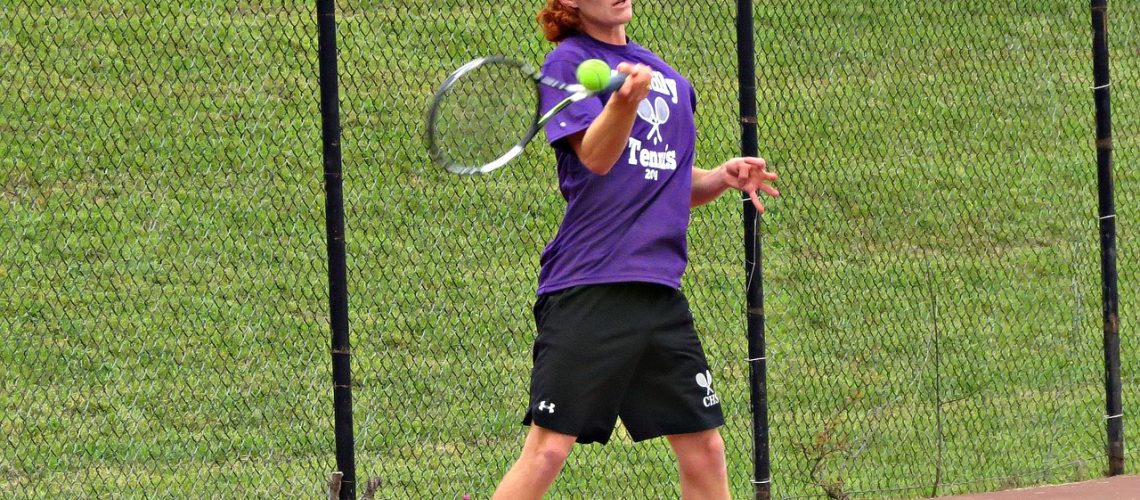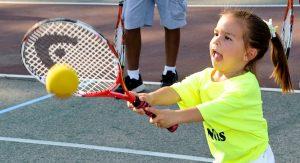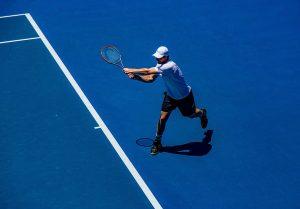We may earn money or products from the companies mentioned in this post.
What Is A Forehand In Tennis?

Tennis is a game of skill, strategy, and finesse One of the most fundamental strokes in tennis is the forehand The forehand stroke involves hitting the ball with the palm-facing side of the racket hand It is a versatile shot that can be executed with power and precision, making it a crucial weapon in any player’s arsenal
The importance of the forehand stroke in tennis cannot be overstated It is often considered the most natural and instinctive shot for players to learn and master The ability to hit a strong and accurate forehand can dictate the flow of a match, allowing players to take control of points and put their opponents on the defensive
History and Evolution of the Forehand Technique

The forehand stroke has come a long way since its early days in tennis In the early years of the sport, players predominantly used an underarm or sidearm motion to hit the ball However, as tennis evolved into a more competitive and athletic game, so did the technique behind executing a forehand
Over time, players began to adopt a more modern approach to their forehands, incorporating rotational movements and employing greater upper body strength This evolution allowed for increased power generation and improved shot accuracy
Early Days of Tennis and Introduction of the Forehand
In its infancy, tennis was played with wooden rackets that had smaller heads compared to today’s modern rackets Players would use an underarm or sidearm motion when hitting shots, including their forehands
However, as technology advanced and rackets became lighter with larger sweet spots, players started experimenting with different techniques to maximize their performance on court This led to an evolution in how players approached their forehands
Changes in Style and Technique Over Time
As tennis continued to evolve, players began to develop more dynamic and powerful forehand techniques The introduction of topspin into the game revolutionized the way forehands were executed
Modern players like Roger Federer and Rafael Nadal have taken the forehand stroke to new heights, using a combination of power, spin, and precision to dominate their opponents Their ability to generate immense racket head speed and hit winners from all areas of the court has set a new standard for what is possible with a forehand stroke
Anatomy of a Proper Forehand Stroke

A proper forehand stroke involves several key elements that work together to produce an effective shot:
Stance and Body Position
The stance is crucial for setting up a strong foundation for the forehand stroke Players typically use an open or semi-open stance, allowing for better weight transfer and rotation during the shot The body should be balanced, with knees slightly bent and weight evenly distributed between both feet
Grip Variations for Different Types of Shots
The grip used on the racket can vary depending on the desired shot type The most common grip for executing a forehand is the Eastern grip, where the base knuckle of the index finger rests on bevel 3 of the racket handle This grip provides stability and control while allowing players to generate power
For shots that require more topspin or slice, players may opt for grips such as the Semi-Western or Western grips, which allow for greater wrist pronation and spin generation
In conclusion,
The Mechanics Of A Perfect Forehand Stroke In Tennis

Tennis is a game of precision, technique, and strategy One of the most crucial shots in a player’s arsenal is the forehand stroke Mastering the mechanics of a perfect forehand can significantly enhance your performance on the court Let’s dive into the key elements that make up an exceptional forehand
The Importance of Footwork
Footwork is the foundation of any successful shot in tennis, and the forehand is no exception Proper footwork allows you to position yourself optimally for each shot, enabling better balance, timing, and power
In different situations on the court, you’ll need to employ various footwork patterns Whether it’s moving forward to attack a short ball or shuffling laterally to defend against a wide shot, being able to adapt your footwork technique accordingly is crucial for executing a perfect forehand stroke
Preparation and Backswing
Before unleashing your forehand power, it’s essential to prepare properly with an efficient backswing This phase sets the stage for generating maximum racket head speed and control during contact with the ball
A proper racket takeback technique involves turning your shoulders sideways while simultaneously extending your non-dominant arm towards the incoming ball This motion helps load energy into your swing and creates a solid foundation for delivering an explosive forehand stroke
The Contact Point with the Ball
The contact point is where magic happens—the moment when your racket meets the ball in perfect harmony Depending on your desired shot selection (flat, topspin, or slice), you’ll need to adjust your contact point accordingly
For flat shots that require pace and accuracy, aim for contact slightly in front of your body, ensuring a clean connection with the center of the strings When going for topspin, strive to make contact slightly higher and more in front of you, brushing up on the back of the ball to generate that coveted spin Finally, for a slice shot, focus on contacting the ball from a low position and slicing across it to create a skidding effect
The Follow-Through and Recovery Phase
The follow-through is just as important as the stroke itself A proper follow-through allows you to maintain balance and control while also facilitating racket acceleration through impact
After making contact with the ball, continue your swing forward while rotating your hips and shoulders towards your target This complete follow-through motion helps transfer power into your shot and sets you up for quick recovery to prepare for the next shot
Mastering the mechanics of a perfect forehand stroke requires practice, patience, and attention to detail By focusing on footwork, preparation and backswing, contact point variation, as well as an effective follow-through and recovery phase, you’ll be well on your way to unleashing formidable forehands that will keep your opponents on their toes
Tips For Improving Your Forehand Technique

Mastering your forehand technique is essential for any tennis player looking to enhance their game Whether you’re a beginner or an experienced player, there are always ways to improve and refine your skills In this article, we will explore some valuable tips to help you elevate your forehand game to the next level
Practice Drills to Hone Your Skills
Practice makes perfect, and when it comes to improving your forehand, consistent practice drills can work wonders There are various drills you can incorporate into your training routine
-
Solo Practice Drills:
Start by focusing on the fundamentals of your forehand stroke Practice hitting against a wall or using a ball machine to develop consistency and accuracy in your shots This will also help you establish good timing and rhythm -
Partner or Group Practice Drills:
Engaging in practice sessions with a partner or group can simulate real match scenarios and add an element of competition Utilize drills that involve rallying back and forth, working on both power and control
Common Mistakes to Avoid When Hitting a Forehand
The key to improving any skill is identifying and rectifying common mistakes that hinder progress Here are two important aspects of the forehand technique that players often struggle with:
-
Fixing Grip Issues:
The grip plays a crucial role in executing an effective forehand shot Ensure that you have the correct grip suited for your playing style – be it Eastern, Semi-Western, or Western grip – as this affects how well you can generate power and spin -
Addressing Poor Footwork:
Proper footwork is vital for positioning yourself correctly and generating power in your shots Focus on maintaining a balanced stance, utilizing the right footwork patterns, and transferring your weight efficiently to optimize your forehand strokes
Advanced Techniques: Adding Variety to Your Game
Once you have mastered the basics, it’s time to add some flair and variety to your forehand game Incorporating advanced techniques can keep your opponents guessing and give you a competitive edge:
-
Incorporating Topspin and Slice into Your Repertoire:
Learning how to utilize topspin can help you generate more control over your shots while adding depth to them Additionally, incorporating slice shots can disrupt your opponent’s rhythm and create opportunities for winning points -
Mastering Specialty Shots: Drop Shots, Angles, Lobs:
Developing specialty shots like drop shots, angled shots, or lobs adds unpredictability to your gameplay These shots can catch your opponent off guard and allow you to take control of the point
By focusing on these tips and consistently practicing with dedication and determination, you will see significant improvements in your forehand technique Remember that each player has their own unique style, so adapt these tips according to what works best for you Keep honing your skills, stay patient with yourself, and enjoy the journey of becoming a formidable force on the tennis court!
Forehands And Strategy: How To Use Your Forehand To Win Games

When it comes to tennis, your forehand can be a powerful weapon that can help you dominate your opponents and win games However, simply relying on the strength of your forehand alone won’t guarantee success To truly maximize the potential of your forehand, it’s important to develop a strategic approach that takes into account both your strengths and weaknesses, as well as those of your opponent
Identifying weaknesses in your opponent’s game
One key aspect of using your forehand effectively is being able to identify weaknesses in your opponent’s game By studying their playing style and observing their shot selection, you can start to pinpoint areas where they may be vulnerable For example, if you notice that their backhand is weaker than their forehand, targeting it with well-placed shots could put them under pressure and force errors
Building points around your own strengths
Another crucial element in utilizing your forehand to win games is building points around your own strengths Every player has their preferred shots and positions on the court where they feel most comfortable As a player with a strong forehand, one effective strategy is to utilize inside-out or inside-in forehands to exploit open spaces on the court and force opponents out of position
Transitioning from defense to offense with powerful forehands
Your forehand can also play an important role in transitioning from defense to offense during a match When you find yourself on the defensive, retrieving difficult shots or defending against aggressive attacks from your opponent, using powerful forehands can help turn the tide in your favor By redirecting the pace and depth of the ball with well-timed swings, you can regain control over the point and shift the momentum in your favor
Court positioning: dictating play with aggressive forehands
Court positioning is another crucial aspect of using your forehand effectively By strategically positioning yourself on the court, you can dictate play and put yourself in a position to unleash aggressive forehands Whether it’s controlling rallies from the baseline or moving forward to attack short balls, being proactive and taking charge with your forehand can keep your opponents on their toes and give you the upper hand
Useful Links

How To Hit The “Heavy” Forehand
The Perfect Beginner Forehand: Swing for the fences!
5 Tips to Improve Your Forehand
Perfect Your Tennis Forehand Technique With Tips …
Tennis Forehand Grip Explained – All 4 Types [Used By Pros!]
Classic vs. Modern Forehand Techniques Compared
Forehand grip and swing for beginner players
Forehand POWER Checklist
The Forehand Slice, Once Disdained, Makes a Comeback
Forehand Tennis Grips
What Is A Forehand In Tennis
Tennis forehand shot – Tennis – essential skills and …
Tennis Forehand Technique: Straight Arm vs Bent Arm
Forehand Tennis Swing: A Comprehensive Guide
What your forehand tennis grip means for shot depth and …
Fed-style Topspin Forehand
How to Hit a Tennis Forehand: Techniques, Grip, and …






